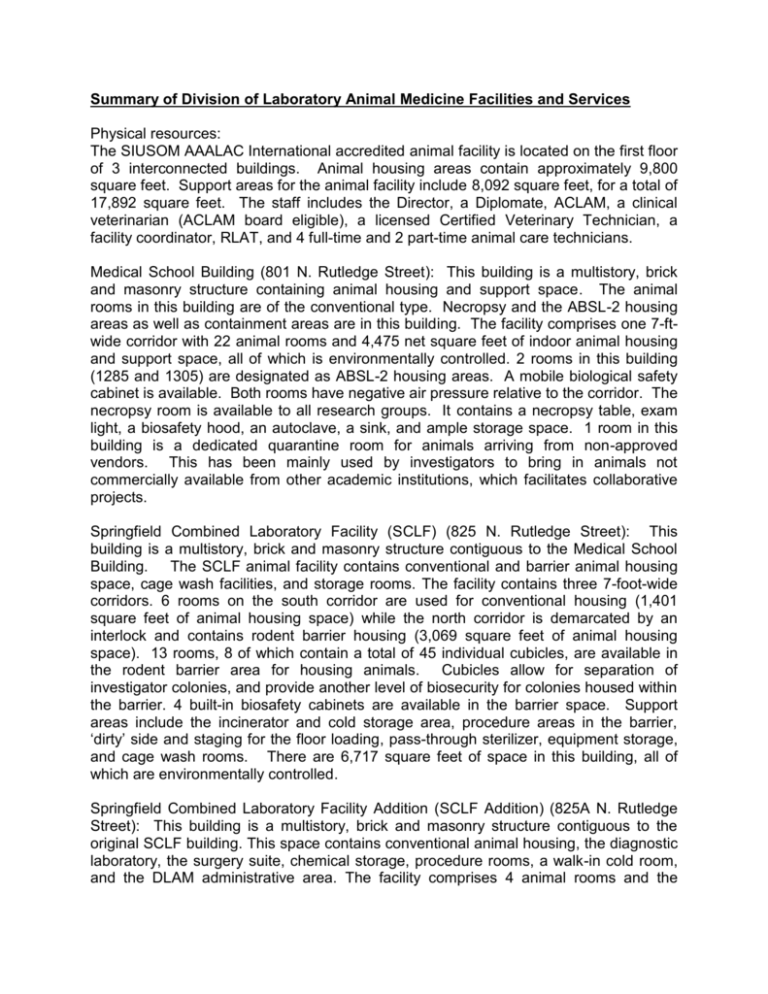Summary of Division of Laboratory Animal Medicine Facilities and
advertisement

Summary of Division of Laboratory Animal Medicine Facilities and Services Physical resources: The SIUSOM AAALAC International accredited animal facility is located on the first floor of 3 interconnected buildings. Animal housing areas contain approximately 9,800 square feet. Support areas for the animal facility include 8,092 square feet, for a total of 17,892 square feet. The staff includes the Director, a Diplomate, ACLAM, a clinical veterinarian (ACLAM board eligible), a licensed Certified Veterinary Technician, a facility coordinator, RLAT, and 4 full-time and 2 part-time animal care technicians. Medical School Building (801 N. Rutledge Street): This building is a multistory, brick and masonry structure containing animal housing and support space. The animal rooms in this building are of the conventional type. Necropsy and the ABSL-2 housing areas as well as containment areas are in this building. The facility comprises one 7-ftwide corridor with 22 animal rooms and 4,475 net square feet of indoor animal housing and support space, all of which is environmentally controlled. 2 rooms in this building (1285 and 1305) are designated as ABSL-2 housing areas. A mobile biological safety cabinet is available. Both rooms have negative air pressure relative to the corridor. The necropsy room is available to all research groups. It contains a necropsy table, exam light, a biosafety hood, an autoclave, a sink, and ample storage space. 1 room in this building is a dedicated quarantine room for animals arriving from non-approved vendors. This has been mainly used by investigators to bring in animals not commercially available from other academic institutions, which facilitates collaborative projects. Springfield Combined Laboratory Facility (SCLF) (825 N. Rutledge Street): This building is a multistory, brick and masonry structure contiguous to the Medical School Building. The SCLF animal facility contains conventional and barrier animal housing space, cage wash facilities, and storage rooms. The facility contains three 7-foot-wide corridors. 6 rooms on the south corridor are used for conventional housing (1,401 square feet of animal housing space) while the north corridor is demarcated by an interlock and contains rodent barrier housing (3,069 square feet of animal housing space). 13 rooms, 8 of which contain a total of 45 individual cubicles, are available in the rodent barrier area for housing animals. Cubicles allow for separation of investigator colonies, and provide another level of biosecurity for colonies housed within the barrier. 4 built-in biosafety cabinets are available in the barrier space. Support areas include the incinerator and cold storage area, procedure areas in the barrier, ‘dirty’ side and staging for the floor loading, pass-through sterilizer, equipment storage, and cage wash rooms. There are 6,717 square feet of space in this building, all of which are environmentally controlled. Springfield Combined Laboratory Facility Addition (SCLF Addition) (825A N. Rutledge Street): This building is a multistory, brick and masonry structure contiguous to the original SCLF building. This space contains conventional animal housing, the diagnostic laboratory, the surgery suite, chemical storage, procedure rooms, a walk-in cold room, and the DLAM administrative area. The facility comprises 4 animal rooms and the surgery suite. 3 portable laminar air floor hoods are available in this section of the animal facility. It contains 5,150 net square feet of indoor animal housing and support space, all of which is environmentally controlled. Located in the procedure rooms, a Faxitron MX-20 digital radiograph equipment is available to support both clinical and research needs. Other imaging capabilities in the procedure rooms include a bioluminescence instrument, supporting primarily research needs. All survival surgery performed on non-rodent mammalian species is conducted in the DLAM surgery suite (room 1655B SCLF addition). This facility can support up to 3 simultaneous surgical procedures, with anesthetic machine, pulse oximetery monitoring, surgical lights, and circulating warm water blankets. The DLAM facility is also equipped with a portable rodent surgery set-up, including a 6 port isoflurane vaporizer unit, induction boxes, rodent nose cones, and warm water circulating surgery stations. This set up can be used in the DLAM surgical suite or either procedure room in the SCLF addition. Species typically housed in these facilities include mice, rats, rabbits, chinchillas, pigs, and guinea pigs. Other species could be accommodated as needed. To date, all animal requests have been accommodated when orders have been placed. Facility space is managed to allow all current investigators to perform research without delay. Other support: A required training program for research staff on humane and ethical animal research consists of a half-day class that is offered monthly (2.5 hours of a lecture presentation, followed by 0.5 hours of facility orientation training). Supplementary educational materials are available on the web site of the ADRFA. Topics covered include: Sources of information on the use of animals in research Regulatory agencies and AAALAC International Reporting improper care or use of animals Alternatives replacement, reduction and refinement Protocol preparation and review Introduction to animal facilities: procedures, procurement, housing, and animal care Security Animal use: biocontainment, barrier housing, surgery, anesthesia and analgesia, signs of pain and disease in animals, euthanasia, iatrogenic conditions Zoonotic disease, allergies, and injuries Public relations and animal welfare/animal rights groups DLAM provides continuing education by contributing to The Research Communique published by the Office of the ADRFA. Examples of recent content include the impact of parasitic infestations on research, IACUC requirements for reporting adverse incidents to OLAW, an overview of approved euthanasia procedures, ordering animals and quarantine procedures. In addition, DLAM staff offers courses such as Mouse Techniques, Rat Techniques, Surgery Skills Basic, Necropsy Techniques, and Breeding Colony Management on a rotating basis. Assistance with Animal Use Protocol development and preparation is readily available for all investigators.






